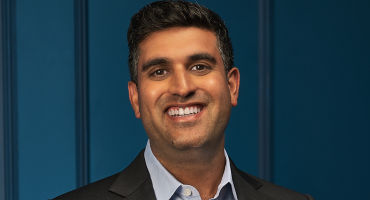- Client Portfolio Manager
Skip to main content
- Funds
- Capabilities
- Insights
- About Us
Asset classes
The views expressed are those of the authors at the time of writing. Other teams may hold different views and make different investment decisions. The value of your investment may become worth more or less than at the time of original investment. While any third-party data used is considered reliable, its accuracy is not guaranteed.
Thematic investing has generated significant interest across the investment community in recent years. In particular, the rise (and potential fall) of thematic index investing is increasingly making headlines. After all, as thematic investing’s profile has risen, it’s only natural that investors have sought out passive options that, on face value, appear to offer the same exposure as an active thematic approach but without the commensurate level of fees.
But can index investing truly provide the same exposure to a thematic opportunity?
We’d argue that it is unlikely, especially over time. In our view, there are two things investors need to consider that may seem obvious but are critical to answering this question:
1. What is a theme?
2. What is an index?
A theme is a top-down, innovative or disruptive trend that has a structural tailwind with the potential to drive above-average stock returns for companies participating in that theme. These themes are evolving continuously, and their returns cannot be easily explained by traditional country, sector or style factors. Examples of themes include fintech, the future of education, energy efficiency and automation, among others. By investing in these themes, investors are assuming that the growth potential of these companies is not yet fully appreciated by the market.
An index is a way to measure the performance of an entire market or a clearly defined segment of the market. By investing in an exchange-traded fund (ETF) replicating an index, an investor is buying an exposure to a market opportunity that, in theory, can be predetermined using a set of rules or a formula. These formulas are typically based on market capitalisation but can also be specified by country, style factor or sector/industry classification.
Very simply, we see it as inconceivable that an investor can predetermine a range of securities that fit neatly into a theme that is constantly evolving. We believe the evolutionary nature of each theme is the exact alpha opportunity that presents itself to active managers.
To evaluate this claim, let’s take, for example, the rise of electric vehicles.
Electric vehicles (EVs) have been in existence for over 100 years; but it has only really been since the introduction of the General Motors EV1 and the Toyota Prius hybrid in the 1990s that the world started to actually consider using electric motors for mainstream automobiles. Jumping forward to today, electric cars have gone from the fringes of society to being seen as the cars of the future.
However, to be the future, EVs — and thereby the theme’s underlying opportunity set — still have significant room for development. Charging and electricity storage technology must continue to progress; costs, power and distance need to be competitive with internal combustion engines; and the issue of battery recycling needs to be addressed.
Importantly, it’s not just the existing car manufacturers that will help to settle these matters and drive long-term opportunities for the EV theme. Battery makers, sensor manufacturers, rare mineral miners and many other EV suppliers and industry players will all play critical roles. As the existing challenges presented by electric vehicles get resolved, new issues will emerge, and the opportunity set will change.
The technology is developing, the theme is evolving and so too must an investor’s thematic exposures. In our view, that’s what gives a theme its alpha potential. With such variables in play, how is it possible for an ETF to predetermine the market of a theme that will continue to evolve well into the future?
We believe that passive implementation raises additional concerns that make it a challenging option for thematic investing.
For example, when we look broadly at the major return generators in equity markets, in many instances, they are disruptors in an existing market. They are the new entrants that shake the foundations of the incumbents. In our view, this is even more pronounced in thematic investing, where the approach is all about identifying the key macro drivers of the future. Active thematic investing allows portfolio managers to seek out these disruptors and adjust course as the theme evolves or the probability of success changes.
Theme purity is also a critical component of thematic investing. We think it’s essential that the companies a thematic portfolio invests in generate the majority of their revenue from the theme. We don’t believe that it’s reflective of a theme to hold a large conglomerate where that theme represents only a small part of the company’s business (and therefore, our exposure). For instance, does buying one of the US-based internet giants really give an investor direct exposure to fintech or autonomous technology? We would argue it does not. Unfortunately, we believe some thematic strategies and ETFs are sacrificing theme purity to raise as much assets as possible.
Furthermore, recent media scrutiny over thematic ETFs has led many to question their legitimacy and, in some instances, that of thematic investing more broadly. In our view, investors are correct to ask these questions as they see a rush of interest in a particular means of investing.
Despite this understandable scepticism, we believe thematic investing, when conducted in a focused and considered manner, has the potential to produce significant alpha and act as a core allocation in a portfolio.
In our view, investors need to avoid broad-based approaches and predetermined markets and, instead, focus on targeted, active, pure-play approaches to thematic investing that can adapt to continually evolving themes. We therefore encourage investors to ask three simple questions before investing:
Question 1. What level of theme purity do you require when selecting a stock for your portfolio?
We believe that stocks in a thematic portfolio must generate the majority of their revenue directly from the theme.
Question 2. How do you research a theme and how granular is your process?
We think that, when researching each theme, we must understand all the inputs required for the theme to play out. It’s not enough to focus solely on the large conglomerates operating in the space.
Question 3. What is the time horizon of the theme?
In our view, themes should play out over a minimum five-year period. In contrast, we think short-term, opportunistic themes are frequently caught up in short-term speculation and media/commercial hype.
We believe thematic investing, much like electric vehicles, represents the future. But just like buying an electric vehicle, investors need to do their due diligence to ensure what they’re buying is what they want. Otherwise, they may have hoped for a supercar but ended up with a lemon. In our view, a targeted, active approach to thematic investing has the potential to help investors better capitalise on the key macro drivers of the future.
Experts


Featured Unique Perspectives

The three hallmarks of an unconstrained bond fund
Portfolio Managers Brij Khurana and Brian Garvey and Investment Director Brian Doherty highlight three key characteristics that they believe every unconstrained bond strategy should incorporate.
URL References
Related Insights

Beyond the hype: finding AI’s long-term winners
Our expert argues that a long-term mindset based on deep research can help to uncover evolving AI investment opportunities amid the hype.
URL References
Related Insights
DISCLOSURE
This material and its contents may not be reproduced or distributed, in whole or in part, without the express written consent of Wellington Management. This document is intended for information purposes only. It is not an offer or a solicitation by anyone, to subscribe for shares in Wellington Management Funds (Luxembourg) III SICAV (the Fund). Nothing in this document should be interpreted as advice, nor is it a recommendation to buy or sell shares. Investment in the Fund may not be suitable for all investors. Any views expressed are those of the author at the time of writing and are subject to change without notice. Investors should carefully read the Key Facts Statement (KFS), Prospectus, and Hong Kong Covering Document for the Fund and the sub-fund(s) for details, including risk factors, before making an investment decision. Other relevant documents are the annual report (and semi-annual report).
© 2025 Morningstar, Inc. All Rights Reserved. The information contained herein: (1) is proprietary to Morningstar; (2) may not be copied or distributed; and (3) is not warranted to be accurate, complete or timely. Neither Morningstar nor its content providers are responsible for any damages or losses arising from any use of this information. The Overall Morningstar Rating for a fund is derived from a weighted average of the three, five, and ten year (if applicable) ratings, based on risk-adjusted return. Past performance is no guarantee of future results.
Issued by Wellington Management Hong Kong Limited. Investment involves risk. Past performance is not indicative of future performance. This document has not been reviewed by the Securities and Futures Commission of Hong Kong.